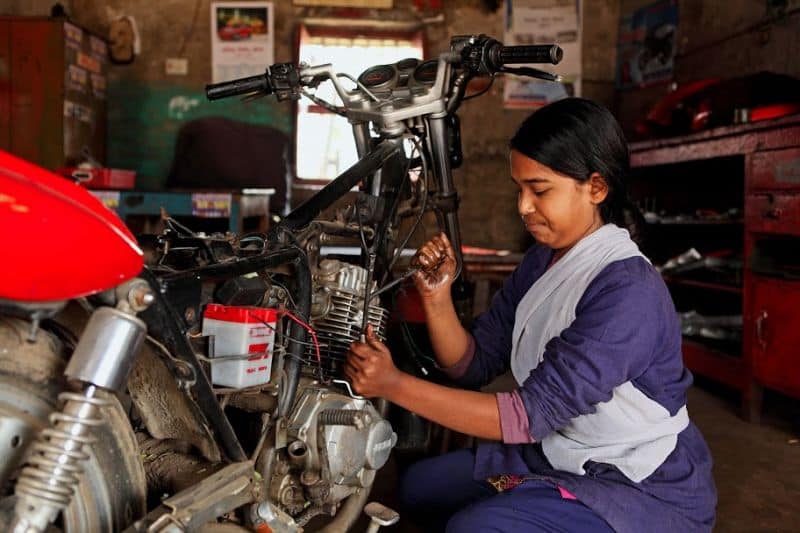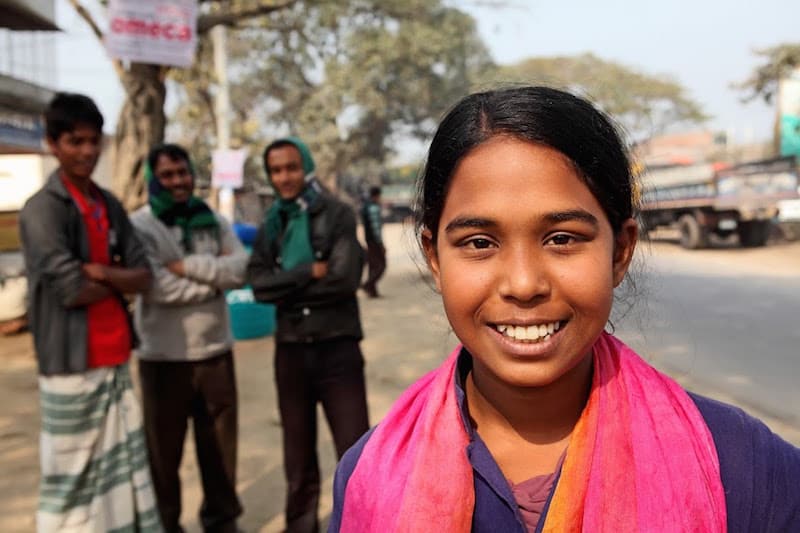Powering Up International Women’s Day – The Skilled Girl Effect
PARITY IN GENDER TRAINING, ACCESS IS LITERALLY WORTH more than the US and Chinese economies COMBINED
A computer whirs and hums to life in the fast-paced, chaotic capital of Dhaka, Bangladesh. Outside of the small shop, rickshaw drivers bargain for fares along the roadside and street sellers call out the day’s fish prices. The phone rings. Hasna Hena, 15, takes the call in one hand, her other hand flying over the track pad to open Photoshop. It’s another new client needing a new poster design.
An hour away in the rural town of Tongi, Mahmuda Akhter, 16, sits in a mobile phone servicing shop in the main market. A client rushes in, wielding his phone and looking stressed. He is greeted by Mahmuda’s calm smile. A small screwdriver in one hand, she pries open the cover of his mobile phone with the other hand. She looks inside and diagnoses the problem immediately.
In the remote outskirts of Rajshahi, six hours outside of Dhaka, a small foot in a blue shoe kick-starts a shiny red and black motorcycle. It roars to life. Khadija Akhter, 18, has fixed it.
“Everything should be fine now,” she says. She jumps on to take it for a test ride around the block so she can be certain. She disappears in a cloud of dust, while the male owner takes a seat.

Khadija Akhter, 18, is working as a motorcycle service mechanic in remote Rajshahi in northern Bangladesh.
Two years ago in Bangladesh, it would have been unheard of for a young woman to be a graphic designer, a phone service provider, or a mechanic – especially in a country where few women drive.
Women are relatively new entrants to the formal workforce in Bangladesh and the majority of them are the first in their families to have a job. As the trend toward greater female employment spreads across the country, women are increasingly taking up leadership positions as well, which has tremendous implications for the country’s workforce.
“If [Bangladesh] stays on track, its female workforce will grow from 34 to 82 percent over the next decade, adding 1.8 percentage points to their GDP,” said Sri Mulyani Indrawati, the chief operating officer and managing director of the World Bank.
The story of economic empowerment is rapidly changing. According to a USAID-funded study, labour force participation for 20- to 24-year-old women in Bangladesh more than doubled in the past 10 years, due largely to the garment boom. The industry now employs over four million workers in the country, 80 percent of them women. Garment exports accounted for $24 billion last year, 80 percent of Bangladesh’s total exports.
A new report from The McKinsey Global Institute indicates that if given the same job opportunities as men, women could contribute $28 trillion to global economic growth. That is roughly equivalent to the U.S. and Chinese economies combined.
There are moral reasons why countries should foster gender equality. Women are more likely to spend their earnings on health, education and investing in the future. Empowering women is also a critical component of each of the UN’s new Sustainable Development Goals. But beyond advocating for gender equality, women’s participation in the workforce also makes economic sense.
Skilled girl effect in action
Brishty Akhter, 18 is a skilled tailor who owns a shop where she trains and employs other girls in southern Bangladesh. When she was 16, she became an apprentice and developed her skills as a tailor. Then she did something unheard of: She convinced her parents to spend the money they had saved for her marriage to buy her a shop so she could start her own business.
In Bangladesh, parents generally spend more money on their daughters’ weddings than on their education. The country still has the fourth highest child marriage rate in the world. A daughter convincing her parents, at just 18 years of age, to completely turn their backs on tradition and to instead invest in her career is unprecedented.
What gave Brishty and her parents the confidence that her shop was a good investment?
Brishty is a graduate of a BRAC skills training pilot programme called Skills Training for Advancing Resources (STAR) that has graduated over 11,000 apprentices in Bangladesh. Over 6,000 of those apprentices are girls. Ninety-five percent of graduates are employed upon completion of the program. Twelve months after the program has completed, research shows that they maintained employment. Graduates are employed in both the informal and formal sectors, or start their own businesses.
The programme pairs apprentices directly with master craftspeople, innovating on the traditional informal apprenticeship model that has existed almost exclusively for men in South Asia for thousands of years. It is significantly cheaper than costly training institutions. After just six months of training, apprentices begin jobs with a combination of relevant trade skills, as well as a suite of soft skills. Women and men are given the same choices of trades to pursue, and trades are chosen based on the demands of an increasingly service-oriented economy, continually mapped through smartphones.
As a result of skills training, Hasna, Mahmuda, Khadija and hundreds of other girls all across Bangladesh are now working in trades like IT, mobile phone repair and motorcycle service. In a region with the lowest gender parity in the world, these women are playing an identical role in the labour market as men. They are working the same hours, and employed in the same sectors.

Thanks to skills training Khadija Akhter is an motorcycle mechanic, a male dominated field to say the least.
According to the Bangladesh Labour Force Survey 2013, labour force participation for women is 33.5 percent, compared to 81.7 percent for men. If female labour participation rates in Bangladesh rose by 2.5 million per year, it would take just ten years for the participation rate to equal the current rate of male participation.
Now we need to give millions more women those opportunities. Empowering girls like Brishty will not only improve the economy, but can also help decrease child marriage and give families the confidence to invest in their children’s future careers.
Gender disparity is a complex issue, but simple solutions exist. Significant political and social changes are also required, but harnessing the skilled girl effect could dramatically accelerate those changes.
It costs a few hundred dollars to equip a girl with skills through an apprenticeship, which far outweighs the cost of their untapped potential. Let’s #PledgeforParity this International Women’s Day. Invest, and they’ll take care of the rest.
All in-post images courtesy of BRAC. Homepage carousel photo credit: Bread for the World.
- Categories
- Education
